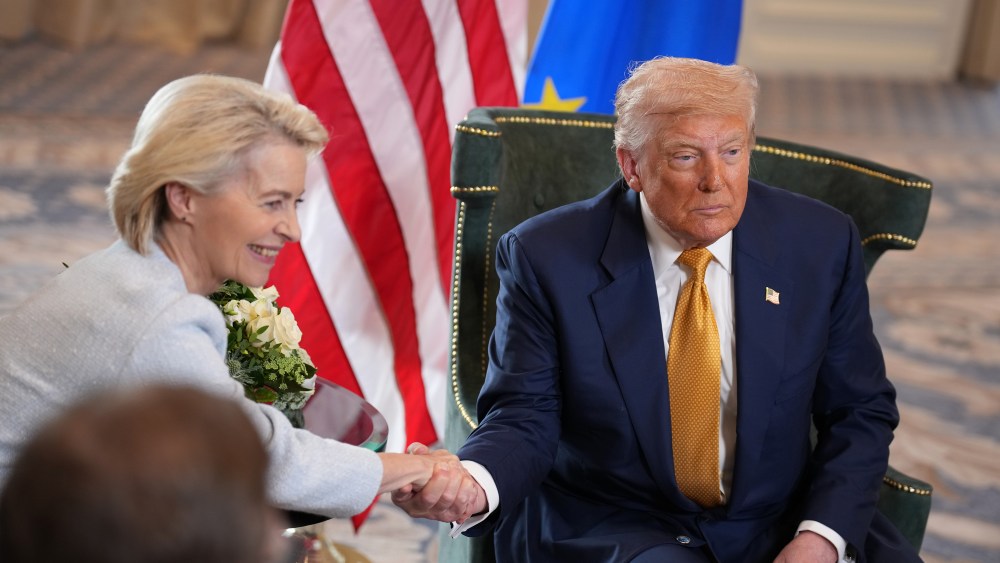
Weeks after announcing the formation of a bilateral trade agreement that President Donald Trump called “the biggest deal ever made,” the United States and the European Union have released much-anticipated details about the framework.
The Big Picture
In a joint statement on Thursday, the trade partners outlined and reinforced certain provisions. Most importantly, the 15 percent duty rate for European imports to the U.S. market that was revealed in late July will persist, though the partners provided crucial details about the interplay between new “reciprocal” tariffs and existing import duties.
“The United States commits to apply the higher of either the U.S. Most Favored Nation (MFN) tariff rate or a tariff rate of 15 percent, comprised of the MFN tariff and a reciprocal tariff, on originating goods of the European Union,” the partners wrote.
As of Sept. 1, Europe-originating products including unavailable natural resources like cork, aircrafts and their parts, generic pharmaceuticals and chemical precursors will face only the MFN rate.
“The United States and the European Union agree to consider other sectors and products that are important for their economies and value chains for inclusion in the list of products for which only the MFN tariffs would apply,” the statement said, indicating some wiggle room for negotiating lower duties on specific EU imports.
The EU committed to eliminate tariffs on all American industrial goods (while also providing preferential access for a range of agricultural products). The U.S. will maintain high tariffs on vehicles until those changes are made, reducing the tariffs on automobiles when the EU fulfills its end of the bargain by removing existing trade barriers.
As with the agreement with Japan — another deal that Trump characterized as the “largest” ever made — the EU has pledged to invest $600 billion across strategic sectors in the U.S. by the end of 2028. “This investment reflects the European Union’s strong commitment to the transatlantic partnership and its recognition of the United States as the most secure and innovative destination for foreign investment,” the statement said.
Tariffs That Impact the Fashion Sector
While the trade partners’ statement was largely in line with what European Commission President Ursula von der Leyen and President Trump shook on last month, the industry was fretting over a key detail.
American Apparel and Footwear Association (AAFA) president and chief executive officer Steve Lamar, along with Council of Fashion Designers of America (CFDA) president Steve Kolb, jointly praised the negotiating teams “for ensuring that the new 15 percent reciprocal rate is not-stacked on top of existing high most-favored nation (MFN) rates that the U.S. fashion industry has long been paying on imports of inputs, equipment, and finished goods.”
The U.S. fashion sector — including brands, retailers and producers — has been waiting with bated breath to see how this element of the deal would shake out.
To illustrate the scope of the win: an imported men’s cotton shirt (not knitted or crocheted) faces an MFN rate of 19.7 percent, and a women’s or girls’ blouse made of man-made fibers (that is knitted or crocheted) faces a 32 percent MFN rate. Under the new deal, products imported from France or Italy that are categorized under those HTS codes could have faced the sum total of the established MFN rates and the new reciprocal duties of 15 percent. But the administration has opted not to “stack” the rates.
“We are urging the U.S. to embrace this vital non-stacking concept in other deals so that the fashion industry can continue to directly and indirectly support more than 10 million U.S. workers as we design, make, market, and sell safe, affordable, authentic, and responsibly-made clothes, shoes, and accessories,” the AAFA and CFDA leads wrote in a statement viewed by WWD’s sister publication Sourcing Journal.
Addressing Duty-dodgers
There are several other elements of the nascent deal that could prove impactful to American fashion firms as it’s rolled out over the coming months.
Notably, the U.S. and the EU in their joint statement stipulated that they plan to negotiate rules of origin “that ensure that the benefits of the Agreement on Reciprocal Trade accrue predominantly to the United States and the European Union.” Further, the statement said, “The United States and the European Union agree to strengthen economic security alignment to enhance supply chain resilience and innovation by taking complementary actions to address non-market policies of third parties as well as cooperating on inbound and outbound investment reviews and export controls, as well as duty evasion.”
A seemingly innocuous statement on its surface, the rules of origin inclusion underscores a fixation evinced by the Trump administration on the issue of “transshipment,” or the rerouting of goods through third countries to avoid high duties. Transshipment clauses — and threats of hefty penalties — have been included in the letters the White House delivered to dozens of trading partners in recent weeks.
The Trump administration has also touted its intent to force all countries to pay the duties they’ve been dealt, saying it will deal with duty dodgers accordingly. Last month, the U.S. Department of Justice said that it’s upping its efforts to promote robust trade enforcement as it anticipates an escalation of issues like tariff evasion (through misclassifying or undervaluing imports, or misrepresenting country of origin) as the tariffs take hold.
Sustainability Standards for American Companies
With the EU at the global forefront of sustainability regulation and legislation for some time (however watered down the rules may have become in recent months) the Trump administration has worried aloud that stringent environmental and labor standards could impede U.S. exports to the regional market and stymie trade growth.
In their joint statement, the trade partners agreed that the EU will “undertake efforts to ensure that the Corporate Sustainability Due Diligence Directive (CSDDD) and the Corporate Sustainability Reporting Directive (CSRD) do not pose undue restrictions on transatlantic trade.”
When it comes to the CSDDD, this will mean taking steps to reduce administrative burdens on businesses (including small- and medium-sized enterprises, or SMEs). The EU has also committed to proposing changes to the requirement for a harmonized civil liability regime for due diligence failures and to climate-transition-related obligations.
Digital Trade Barriers
As recently as last week, it appeared that landmark EU legislation regulating players in the digital realm might prove to be a stumbling block in the finalization of the trade truce.
The law, which aims to safeguard European citizens against illegal content, disinformation, deceptive advertising, data mining and more, targets “very large online providers” (VLOPs) including American firms like Facebook, Amazon and Google. (Foreign marketplaces like AliExpress, Shein, Temu and Zalando are also subject to the most stringent of standards under the law, so it’s not just U.S. firms being singled out.)
Thursday’s statement appears to address U.S. compliance with the DSA as a work in progress. In addition to both parties committing that they will not take actions like adopting or maintaining network usage fees, imposing customs duties on electronic transmissions, “The United States and the European Union commit to address unjustified digital trade barriers,” the statement said.
#U.S #Release #Details #Bilateral #Trade #Deal






